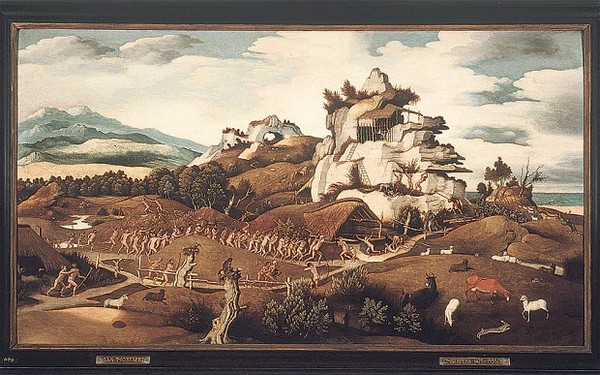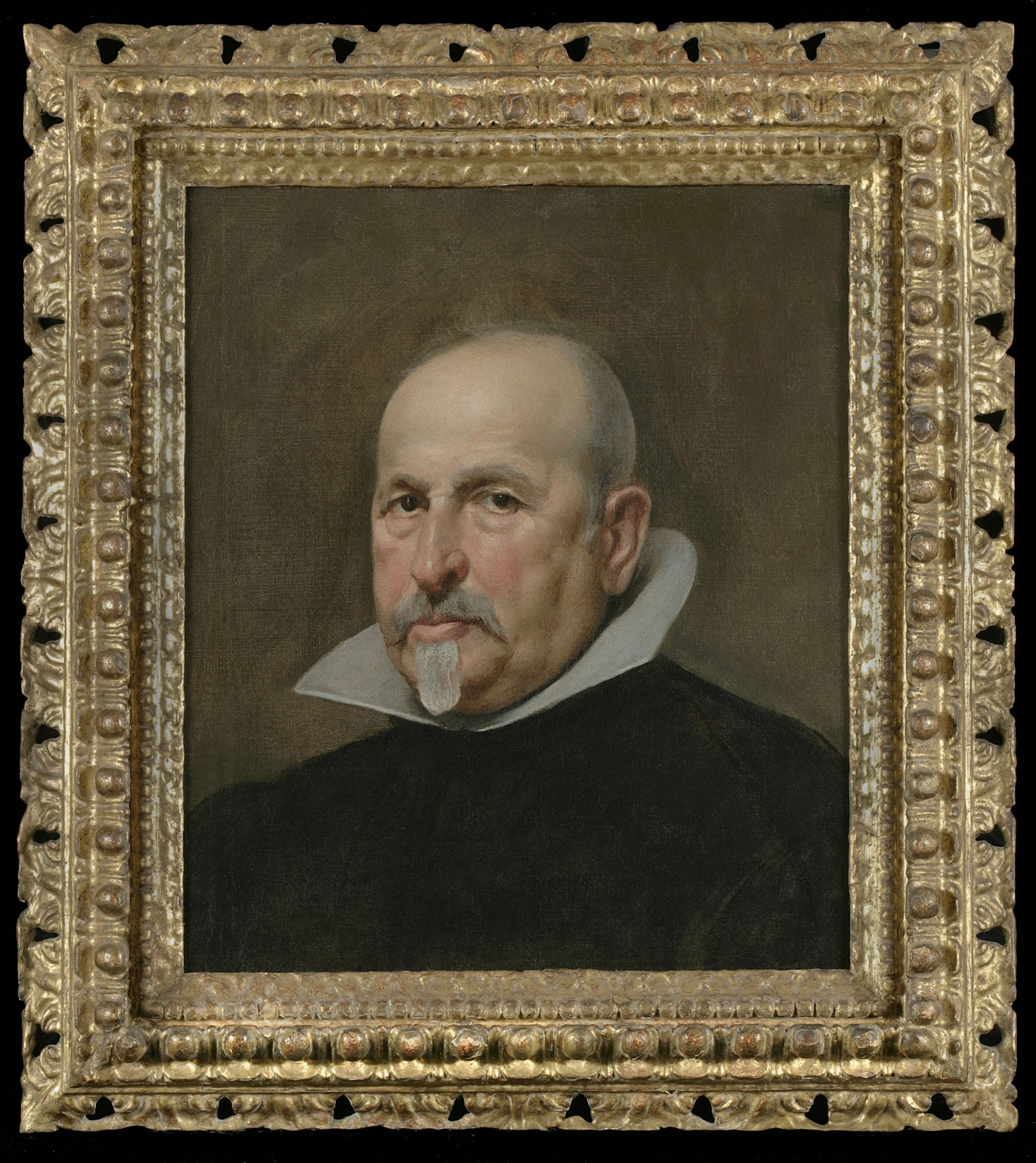
Early America Never Looked So Much Like Hieronymous Bosch
TEFAF — More than a Few Museums in Maastricht
It’s often said that The European Fine Art Fair in Maastricht, Netherlands is like a museum. True enough, but few museums have such a vast range of objects. Few have such good ones.
Museums were certainly buying at Maastricht, and every year that I have visited the art fair that specializes in Old Masters, there has been a painting for a huge price on the wall of the booth of Dickinson, a venerable London gallery that journeys to Holland each March.
This year it was Episode from the Conquest of America, by Jan Mostaert, a view of the New World that comes as much from the artist’s wild imagination (and perhaps from an explorer’s commission) as it does from the accounts of explorers who made it back. It’s said to be the first depiction of America, which explains why Dickinson is asking $14 million for it. That also explains why Dickinson believes that an American museum would pay such a high price.
This not an undiscovered painting, nor is it a resurrected one. Its history is even more fascinating. The painting was the property of Jacques Goudstikker, a Dutch Jewish dealer and collector whose property was looted by the Nazis. After the war, when the pictures were recovered, they were viewed as the property of the Dutch state, which “loaned” them to museums around Holland. Episode from the Conquest of America was at the Frans Hals Museum in Haarlem for decades. After the pictures were restituted to the family of Jacques Goudstikker (now in Greenwich, Connecticut), the painting went on view in an exhibition of those restituted works which premiered at the Bruce Museum in Greenwich and traveled to other institutions. At that time, well-placed sources say, the asking price was $5 million. Some say it was higher back then, too.
It’s unlikely that anyone will pay the $14 million – lower than the rumored peak asking price of $20 million not long ago — but Mostaert painted a wild scene with some truth to it. Think of a sparse dry rocky landscape by Hieronymous Bosch. A line of nude figures is winding toward the middle of the canvas. Troops in armor are snaking toward the center from a beach on a turquoise sea in the background. When the two human lines meet, men, women and children are speared, and some of the naked figures – meant to be American savages – hurl rocks down on the invaders. At those intersections, the encounters are bloody and violent. It’s a mismatch. It’s clear who the invaders are, and it’s clear who’s likely to win. For a recent evocation on film of the “contact” that we observe in Moestart’s picture, see Even the Rain (Tambien la Lluvia) by Iciar Bollain.
It’s still a European racially-profiled version of America, although “native” people are as fair-skinned as the Dutch. Long beards and nakedness are signs of savagery in the first moments of the conquest, as reported by travelers on Hernan Cortez’s expeditions – and re-reported by a Dutch painter. Some art historians say that the scene depicted is Coronado’s expedition to New Mexico, which dates the picture around 1540, but that conclusion doesn’t explain the boats in the turquoise water in the background.
So far the picture, which always has a group in front of it at the Dickinson booth in Maastricht — hasn’t sold. Will the right American billionaire step up? Steven Spielberg? A Walton heiress in Arkansas? Steve Wynn? Steve Forbes? Steve Martin? Steve Carell? Was there another billionaire to buy a recently rediscovered portrait by Diego Velasquez, for sale, also for $14 million, at Otto Naumann? Naumann bought the painting at Bonham’s in London in 2011 for $4.7.

A Bargain Velasquez for $14 million?
Another rarity at TEFAF that you won’t see anywhere else is Nasturtions, a drawing by Otto Dix of a couple inebriated in lust, at Richard Nagy. On blue paper, Dix drew an innocent young man with his arm around the shoulder of an older and wiser woman who looks as if she’s been around the block with plenty of others. In the mix of the two dispositions, you think of William Blake’s Songs of Innocence, Songs of Experience, or of a visitor from the country who is about to run head-on into a city girl’s guile. Dix tends to mine a grotesquery that turns monstrous; here you see credulity pointing to a worse fate at the hands of a woman pickled by the hard knocks of life – sweet and sour.
 There’s more to the deceptively simple image. Paul Cadmus comes to mind, for his scenes like The Fleet’s In, where drunken sailors leap at anything. (Feel free to substitute another verb there.) Part of what might have also inspired it is the spoof on a kitschy Bavarian love scene – a lot more refreshing than how Jeff Koons might use the same treacly pop subject matter. You also see Dix’s skill in a more academic approach to drafting than what you get in his scenes of horror. At 800,000 euros, it’s a picture that a museum might want – or should want.
There’s more to the deceptively simple image. Paul Cadmus comes to mind, for his scenes like The Fleet’s In, where drunken sailors leap at anything. (Feel free to substitute another verb there.) Part of what might have also inspired it is the spoof on a kitschy Bavarian love scene – a lot more refreshing than how Jeff Koons might use the same treacly pop subject matter. You also see Dix’s skill in a more academic approach to drafting than what you get in his scenes of horror. At 800,000 euros, it’s a picture that a museum might want – or should want.
For those who want the more classic Otto Dix, there was a drawing of a dominatrix – in what looked like the form of the letter X (St. Andrew’s Cross? – up the stairs in the fair’s section devoted to works on paper. It was only 24,000 euros, about $35,000.
Not that there was a lack of grotesquery at Maastricht, if that’s your passion. Martyrdom is the stuff of religious painting, and Blumka Galery of New York had an extraordinary relief of the Flagellation of Christ. Was it just a coincidence that a new pope was being chosen when the fair opened? The object was a rarity of rarities—it was English, from the mid-15th century – the kind of work that Oliver Cromwell and company would have crushed into dust.

Jeff Koons’s “Venus” and TEFAF’s Guard
Saying something positive about Gagosian Gallery is like singing the praises of a too-big-to-fail banker (no doubt some of those shop at the gallery). This year, Gagosian’s booth choreographed a shrewd march from a Jeff Koons Venus, with a tall security guard alongside it of comparable monumental size, to two Picasso portraits of his blonde teenaged girlfriend Marie-Therese Walter (one $12m and other $8 million, both from the magisterial exhibition organized by John Richardson at Gagosian in New York in 2011), to Rudolf Stingel’s larger-than-life photo composition of Picasso. From absurdity to profundity to mute admiration.
More soon about TEFAF’s annual survey of the art market.
